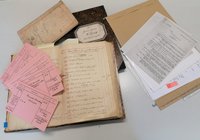About the collection
This collection comprises the objects that were processed in the course of the research project on the "Reappraisal of collections from colonial contexts in the Museum Ulm" from September 2021 to December 2022.
The project was funded by the Baden-Wuerttemberg Ministry of Science, Research and Art's part of the overall strategy on colonial responsibility of the state government of Baden-Wuerttemberg and the "3 Wege-Strategie" adopted by the federal, state and local governments in 2020.
Around 220 ethnographic objects were examined, most of which came to the Gewerbemuseum Ulm (Museum of Applied Arts), the predecessor institution of the present museum, as loans or donations and are still preserved in the collection today.
The objects identified as non-European come from African countries, from parts of Oceania and Australia, or from China, among others, and include mainly weapons, jewelry, clothing, and utilitarian objects. For the most part, they were created at the end of the 19th, beginning of the 20th century or are older and arrived at the museum during this period.
The project comprised the three case groups according to the definition of the German Museum Association: 1. collection items from formal colonial rule (e.g., the objects from Cameroon), 2. objects from regions which were not subject to formal colonial rule at the time of production or acquisition, but in which influences of informal colonial structures worked (e.g. vessels from Peru or objects from Northern America) and a few items that could be ascribed to case 3 "Objects that reflect colonialism".
(cf. Deutscher Museumsbund, Guidelines for German Museums: Care of Collections from Colonial Contexts, 2021)
In addition, some objects are included whose place and time of origin are not definitely known, but for which a connection with colonial contexts cannot be excluded.
Other non-European ethnographica are on hand in the museum's collection within the cabinet of arts and curiosities of Christoph Weickmann. These are older and were probably created before the mid-17th century; however, the attribution to the Wunderkammer is not certain for all objects. Even though the objects thus largely date from pre-colonial times, they sometimes come from countries that were initially affected by European expansion and later in part by colonialism. For the sake of completeness, the non-European objects in question, which are currently assigned to the Weickmann Collection, were therefore also published in the course of the project.
